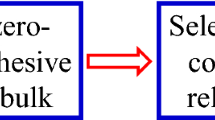Abstract
Tensile strength is one of the key factors of concrete material that need be accurately defined in analysis of concrete structures subjected to high-speed impact loads. Dynamic tensile strength of concrete material is usually obtained by conducting laboratory tests such as direct tensile test, Brazilian splitting test and spall test. Concrete is a heterogeneous material with different components, but is conventionally assumed to be homogeneous, i.e., cement mortar only, in most previous experimental or numerical studies. The aggregates in concrete material are usually neglected owing to testing limitation and numerical simplification. It has been well acknowledged that neglecting coarse aggregates might not necessarily give accurate concrete dynamic material properties. In the present study, a 3D meso-scale model of concrete specimen with consideration of cement mortar and aggregates is developed to simulate spall tests and investigate the behaviour of concrete material under high strain rate. The commercial software LS-DYNA is used to perform the numerical simulations of spall tests. The mesh size sensitivity is examined by conducting mesh convergence tests. The reliability of the numerical model in simulating the spall tests is verified by comparing the numerical results with the experimental data from the literature. The influence of coarse aggregates on the experimental test results is studied. The wave attenuation in concrete specimen is analysed, and empirical equations are proposed for quick assessment of the test data to determine the true dynamic tensile strength of concrete material. The contributions of aggregates to dynamic strength in spall tests are quantified for modifying the test results based on mortar material in the literature.


















Similar content being viewed by others
References
Brara A, Klepaczko JR (2006) Experimental characterization of concrete in dynamic tension. Mech Mater 38:253–267
Brara A, Camborde F, Klepaczko JR, Mariotti C (2001) Experimental and numerical study of concrete at high strain rates in tension. Mech Mater 33:33–45
Daimaruya M, Kobayashi H, Nonaka T (1997). Impact tensile strength and fracture of concrete. In: Proceedings of the international conference EURODYMAT 97. J Phys Coll C3:C3–253
Erzar B, Forquin P (2010) An experimental method to determine the tensile strength of concrete at high rates of strain. Exp Mech 50:941–955
Gálvez Díaz-Rubio F, Rodríguez Pérez J, Sánchez Gálvez V (2002) The spalling of long bars as a reliable method of measuring the dynamic tensile strength of ceramics. Int J Impact Eng 27:161–177
Gomez JT, Shukla A, Sharma A (2001) Static and dynamic behavior of concrete and granite in tension with damage. Theor Appl Fract Mech 36:37–49
Hao Y, Hao H (2011) Numerical evaluation of the influence of aggregates on concrete compressive strength at high strain rate. Int J Prot Struct 2(2):177–206
Hao Y, Hao H (2013) Numerical investigation of the dynamic compressive behaviour of rock materials at high strain rate. Rock Mech Rock Eng 46(2):373–388
Hao Y, Hao H, Li ZX (2009) Numerical analysis of lateral inertial confinement effects on impact test of concrete compressive material properties. Int J Prot Struct 1(1):145–167
Hao Y, Hao H, Zhang X (2012) Numerical analysis of concrete material properties at high strain rate under direct tension. Int J Impact Eng 39:51–62
Hao Y, Hao H, Jiang GP, Zhou Y (2013) Experimental confirmation of some factors influencing dynamic concrete compressive strengths in high-speed impact tests. Cem Concr Res 52:63–70
Jones J, Wu C, Oehlers DJ, Whittaker AS, Sun W, Marks S, Coppola R (2009) Finite difference analysis of simply supported RC slabs for blast loading. Eng Struct 31:2825–2832
Klepaczko JR, Brara A (2001) An experimental method for dynamic tensile testing of concrete by spalling. Int J Impact Eng 25:387–409
Landis EN, Shah SP (1995) Frequency-dependent stress wave attenuation in cement-based materials. J Eng Mech 121(6):737–743
LSTC (2007) LS-DYNA version 971 keyword user’s manual. Livermore Software Technology Corporation, California
Malvar LJ, Crawford JE (1998) Dynamic increase factors for concrete. In: Twenty-Eighth DDESB seminar, Orlando, FL
Malvar LJ, Crawford JE, Wesevich JW, Simons D (1997) A plasticity concrete material model for Dyna3D. Int J Impact Eng 19:847–873
Philippidis TP, Aggelis DG (2005) Experimental study of wave dispersion and attenuation in concrete. Ultrasonics 43:584–595
Schuler H, Mayrhofer C, Thoma K (2006) Spall experiments for the measurement of the tensile strength and fracture energy of concrete at high strain rates. Int J Impact Eng 32:1635–1650
Tedesco JW, Ross CA, McGill PB, O’Neil BP (1991) Numerical analysis of high strain rate concrete direct tension tests. Comput Struct 40(2):313–327
Wang LL (2007) Foundations of stress waves, English edition (National Defense Industry Press, China, 1985; 2nd Edition, 2005). Elsevier, Amsterdam
Weerheijm J, Van Doormaal JCAM (2007) Tensile failure of concrete at high loading rates: new test data on strength and fracture energy from instrumented spalling tests. Int J Impact Eng 34:609–626
Wu HJ, Zhang QM, Huang FL, Jin QK (2005) Experimental and numerical investigation on the dynamic tensile strength of concrete. Int J Impact Eng 32:605–617
Yan DM, Lin G (2006) Dynamic properties of concrete in dynamic tension. Cem Concr Res 36:1371–1378
Zhang L, Hu SS, Chen DX, Yu ZQ, Liu F (2009) An experimental technique for spalling of concrete. Exp Mech 49:523–532
Zhou X, Hao H (2008) Mesoscale modeling of concrete tensile failure mechanism at high strain rate. Int J Comput Struct 86:2013–2026
Zhou X, Hao H (2008) Modelling of compressive behaviour of concrete-like materials at high strain rate. Int J Solids Struct 45(17):4648–4661
Acknowledgments
The first author would like to acknowledge China National Natural Science Foundation (Grant nos: 11390361 and 11102195) for financial support to carry out this study. The second and third authors would like to acknowledge Australian Research Council (Grant no: DP130104332) for financial support to carry out this study.
Author information
Authors and Affiliations
Corresponding author
Rights and permissions
About this article
Cite this article
Chen, G., Hao, Y. & Hao, H. 3D meso-scale modelling of concrete material in spall tests. Mater Struct 48, 1887–1899 (2015). https://doi.org/10.1617/s11527-014-0281-z
Received:
Accepted:
Published:
Issue Date:
DOI: https://doi.org/10.1617/s11527-014-0281-z




